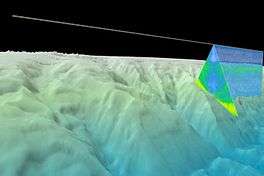Deep scattering layer
_(leszcz).jpg)
The deep scattering layer, sometimes referred to as the sound scattering layer, is a name given to a layer in the ocean consisting of a variety of marine animals. It was discovered through the use of sonar, as ships found a layer that scattered the sound and was thus sometimes mistaken for the seabed. For this reason it is sometimes called the false bottom or phantom bottom. It can be seen to rise and fall each day in keeping with diel vertical migration.
Sonar operators, using the newly developed sonar technology during World War II, were puzzled by what appeared to be a false sea floor 300–500 metres deep at day, and less deep at night. Initially this mysterious phenomenon was called the ECR layer using the initials of its discoverers.[1] It turned out to be due to millions of marine organisms, most particularly small mesopelagic fish, with swimbladders that reflected the sonar. These organisms migrate up into shallower water at dusk to feed on plankton. The layer is deeper when the moon is out, and can become shallower when clouds pass over the moon.[2] Lanternfish account for much of the biomass responsible for the deep scattering layer of the world's oceans. Sonar reflects off the millions of lanternfish swim bladders, giving the appearance of a false bottom.[3]
Description

The phantom bottom is caused by the sonar misinterpreting as the ocean floor a layer of small seagoing creatures that congregate between 1,000 and 1,500 feet (300 and 460 m) below the surface.[4][5] The name is derived from the fact that the first people to see these measurements erroneously reported that they had discovered sunken islands.[5] At night, the layer disappears as the small creatures composing the phantom bottom move to the surface.[5]
Most mesopelagic organisms, including mesopelagic fish, squid and siphonophores, make daily vertical migrations. They ascend at night into the shallow epipelagic zone, often following similar migrations of zooplankton, and return to the mesopelagic depths for safety when there is daylight.[6][7][8] These vertical migrations often occur over large vertical distances. Fish undertake these migrations with the assistance of a swimbladder. The swimbladder is inflated when the fish wants to move up, and, given the high pressures in the messoplegic zone, this requires significant energy. As the fish ascends, the pressure in the swimbladder must adjust to prevent it from bursting. When the fish wants to return to the depths, the swimbladder is deflated.[9] Some mesopelagic fishes make daily migrations through the thermocline, where the temperature changes between 10 and 20 °C, thus displaying considerable tolerances for temperature change.
Sampling via deep trawling indicates that lanternfish account for as much as 65% of all deep sea fish biomass.[10] Indeed, lanternfish are among the most widely distributed, populous, and diverse of all vertebrates, playing an important ecological role as prey for larger organisms. The estimated global biomass of lanternfish is 550–660 million metric tonnes, about six times the annual tonnage captured worldwide by fisheries.[3]


|
|
See also
References
- ↑ Hersey JB and Backus RH (2005) "Sound Scattering by Marine Organisms" In: M. N. Hill and A. R. Robinson (Eds)Physical Oceanography, Page 499, Harvard University Press. ISBN 9780674017276.
- ↑ Ryan P "Deep-sea creatures: The mesopelagic zone" Te Ara - the Encyclopedia of New Zealand. Updated 21 September 2007.
- 1 2 R. Cornejo, R. Koppelmann & T. Sutton. "Deep-sea fish diversity and ecology in the benthic boundary layer".
- ↑ Rachel Carson (29 March 2011). The Sea Around Us. Open Road Media. pp. 33–36. ISBN 978-1-4532-1476-3. Retrieved 20 June 2013.
- 1 2 3 Rachel Carson (1999). Lost Woods: The Discovered Writing of Rachel Carson. Beacon Press. p. 81. ISBN 978-0-8070-8547-9. Retrieved 20 June 2013.
- ↑ Moyle and Cech, 2004, p. 585
- ↑ Bone & Moore 2008, p. 38.
- ↑ Barham EG (May 1963). "Siphonophores and the Deep Scattering Layer". Science. 140 (3568): 826–828. doi:10.1126/science.140.3568.826. PMID 17746436. Retrieved 2008-07-10.
- ↑ Douglas EL, Friedl WA and Pickwell GV (1976) "Fishes in oxygen-minimum zones: blood oxygenation characteristics" Science, 191 (4230) 957–959.
- ↑ Hulley, P. Alexander (1998). Paxton, J.R.; Eschmeyer, W.N., eds. Encyclopedia of Fishes. San Diego: Academic Press. pp. 127–128. ISBN 0-12-547665-5.
- 1 2 Water Column Sonar Data National Geophysical Data Center, NOAA.
Further references
- Bone Q and Moore RH (2008) Biology of Fishes Taylor & Francis Group. ISBN 978-0-415-37562-7
External links
- Deep scattering layer Britannica online.
